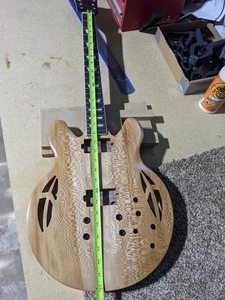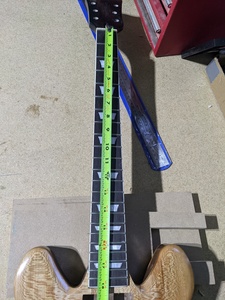Hi Everyone,
I recently tried building my own guitar. I have a body and I bought a pre made neck. I knew nothing about scale at the time, and how important it is for the guitar to ya know sound like a guitar. I should have studied up more and done my homework, but I didn't and here I am trying to save the guitar body that I made.
Does anyone know of a way that you can get scale from the body of the guitar instead of from the neck?
I have a 24 1/2 inch scale neck right now, but when I put it on the body of my guitar the intonation point is at 26 1/2. Is there any saving my guitar or should I just hang it up on this one?
I plan on making a guitar using Marks plans I just didn't want to feel like my time was wasted on this first one.
Thanks in advance,
Erik
Hello there, it would be good if you could upload some pictures so we can have a look. Yes it is possible to alter the guitar body so the scale length will be correct for your neck. However, you will have to route out more wood from the body, going further back towards the bridge. If you have already routed a pickup cavity at the neck then this could be problematic. But, you could fill in the cavity with a block of wood and reroute. The most important thing is making sure the scale length is correct, with slight adjustment for intonation. I am assuming this is a bolt-on neck you have bought and it’s not going to be a set-neck? Everything is fixable, it just depends how much work you want to put in. Sometimes it’s easier to forget it and make another from scratch though.
Hi Boo,
Thanks for your reply. I will post pictures later with a tape measure and the neck attached loosely. It is a bolt on neck, but the pick up pockets are already cut out. I was planning on moving on to a different build, even though I really like how this guitar turned out I understand now how important measuring and scale is. The only option I see right now to maybe fix this guitar is to make it a set-neck and route out some of the neck pick up pocket.
Hello Erik, that is an interesting problem. I don't think it's possible for a 24.5" scale neck to intonate at anything other than 24.5". Can you post some photos of your body and neck wirh your tape measure in place and let us see where you're measuring to.
Hi Robin,
I will post pictures later tonight. Thanks for your reply, it is indeed a unique issue. Learned a lot from this build, mostly that I need training haha.
Most of us still have "learning opportunities" in every build.
No matter that some of us have done plenty of builds before - we still find new things to learn!
It's difficult to comment/advise without seeing photos.
But, in summary, the measurement from the nut to the 12th fret is *always* half the scale length. The bridge must be placed at the scale length (ie as far away from the 12th fret as the nut it).
If you've got pickup cavities already in the wrong place, then you can always cap the guitar, and re-make them in the right place. Just need to be able to get the body/neck join in the right place so the 12th fret is mid-point of the scale length.
I never though about capping, that is an awesome idea. Thank you so much!
Hi Erik,
I am not sure I entirely understand your dimensions. Are you saying that with the neck on the bridge to nut measurement is 2" more than it should be?
I really doubt that all is lost! The important thing is to remember that your 12th fret is exactly half way along the entire scale length. In other words, you need to be able to position the neck such that the 12th fret is equidistant from the nut and the bridge positions. If you can't move the bridge then you have to move the neck relative to the body, if you can't move the neck then you will have to adjust the bridge position. If you cant do either (if you have a set neck already glued in place) then you have to decide whether to save either the neck or the body.
Darren
Hi Darren,
Thank you for your reply, I am going to post pictures later tonight to give a better idea of what is wrong with the guitar. I appreciate the optimism, but this seems like it is going to take a miracle to fix this one. It is a bolt on neck but I am completely open to make a set neck if that will fix it.
Erik
@luthierik
These are just the kind of puzzles that I like. My thoughts so far are to make a new neck of a scale length to fit your body. Then make a new body to fit your 24.5" neck. Given the dimensions the cutouts and bridge position on your existing body, I'm sure we could figure out what scale length would match it. Once you've posted your photos, I'm sure there will be lots of advice heading your way.
Thanks Robin!
I am glad to be a part of this amazing community, pictures coming soon.
Ahhhhh - that's some beautiful work!
The problem is - I think - the placement of the bridge mounting holes (and bridge pickup cavity). Unless it's a perspective effect from the photos, when comparing the placement of the bridge holes against a standard 335, yours appear to be a lot closer to the end of the body. Also looks like there's a lot more space between the two pickup cavities than on the standard 335.
You're either going to have to bring the neck further into the body (by about 2"), or make a neck with a scale length closer to a baritone length.
Bringing the neck into the body will be difficult as you can't really cap that one to hide the re-work and upper fret access will then be difficult. Plus, it will look odd!
Whether making a neck to fit is viable will depend on the measurements. I'd probably draw it out to be absolutely certain. It might be that you have to reduce the number of frets on a new neck to get it all to "work" - ie to balance the scale length and end-of-neck/fretboard position.
On a more positive note - that's a stunning looking piece of work on the body. If you've done that once, you can do it again!!
Hi @tv1,
Thank you for the reply, and guitar appreciation. I am probably going to just make a longer neck it seems like, and possibly change this to a bass guitar. I never thought about making a bass until I messed this one up though. I will maybe have someone who is interested in buying it when I do convert it to that. I have never seen a 335 bass but there is a first time for everything. This is all great advice really appreciated! I will be sure to update the group when I have more progress.
Hi Erik,
That is a really beautiful lacewood body and a very lovely neck! I agree with Robin, what you have here are two lovely parts of two completely separate guitars, it’s just that they are never destined to make music together. You need to measure the distance from the bridge to the neck joint with the body and decide which fret you want at this position. If you let me know this measurement I can suggest a suitable scale length for you to cut your fretboard to. Bolt on was such a good answer, what are you worrying about? This barely registers as a problem to be honest, just a really good excuse to make two guitars rather than one!
Darren
Hi Erik, that is a beautiful body, we can't allow that to go to waste. I'm absolutely certain that you can make a neck to work here. As Tony says, draw it out accurately at full size. You don't need to draw the full body shape, just the centre line, post holes, bridge position, neck pocket and space for a long neck. Now, how to find the scale length backwards ? From the bridge position you should be able see where your intonation line is, from there mark the theoretical scale length line. Mark the position of the 22nd fret your 24.5" neck. Measure accurately from the 22nd fret to scale length line, call this dimension "D", it looks approx 8.5" on your photos. Now choose a neck scale length, lets try 25.5" to start with. Now subtract "D" from Scale length (25.5 - 8.5 = 17.5) call this dimension "F". Now go online to StuMac's fret calculator fret https://www.stewmac.com/fretcalculator.html and select 22 frets and 25.5" scale. Now look down the result chart to find the nearest fret to match dimension "F". In this case fret 20 = 17.468" which is fairly close. Add this to your drawing with the nut at 25.5" from the scale length line and see how it looks. Try this process with other scale lengths, the more frets you want, the longer it will have to be. As Darren says, decide how many frets you want then go from there. This seems a bit complicated written out but its really not. Just one more thing, its a bit difficult to see in your photos, but make sure that you're measuring from the fretboard side of the nut. Good luck.
Robin
Hi @robin,
Thank you for the great advice, and the method of how to figure this out. I will be calculating this over the weekend and figure out what wood to use for the neck and the fret board, as well as the scale of it. I broke apart an old dresser that I had sitting in the area I made in to my shop, and it had similar lace wood in it as the drawer panels(how lucky). I will likely make the fretboard using one of the darker pieces of that wood and go from there. You have all been really great in giving advice I really appreciate it.
Thanks,
Erik
@luthierik
Hi Erik, I'm happy to help. I've had lots of help and advice from this group, I'm glad to be able to give something back. That's a luck find with the dresser, I'm going to be scouring the second hand furniture shops once we're allowed free movement. Keep us posted on your progress.
Robin
If I'm calculating this properly then roughly speaking with the body as it is, you're looking at the same scale length of neck but only 17 frets, or the same number of frets but about a 31 inch scale length (or some intermediate combination of number of frets and scale length)
Personally I'd say congratulations, you've built a very cool short scale bass.
It could just be the angle of the photos, but those bridge posts don't look symmetrical to the centre line to me.
Hi @jonhodgson,
I think it is the angle of the tape measure that is throwing it off. I may have to remove these completely though because of retooling the guitar. Thanks for the idea on the bass though. I think that is probably what I am going to turn this guitar in to. Now I just have to figure out how to make a bass guitar and scale lengths to do so.
@luthierik
Short scale basses are typically between 30 and 32 inches, which should work out about right from my rough calculations based on what I see in the pictures.
Personally, I'd also consider moving the neck pickup back a little bit and make some custom pickup surrounds out of figured wood to cover any nasties.
I would say yes, your numbers tally with my method. I think Erik has to go in between there some to get something that he can use.
I'm hoping that the offset look is just an optical illusion with the camera angle and the tape not being on the centre line.






